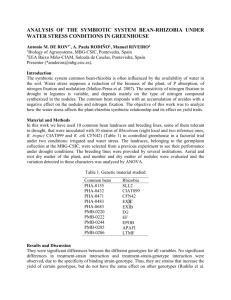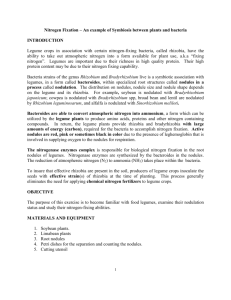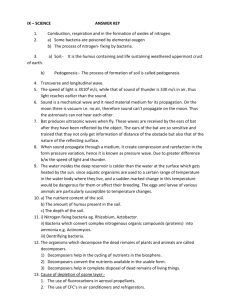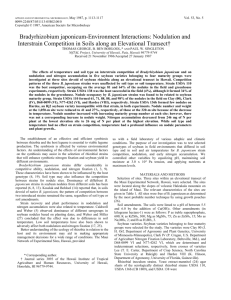How to Conduct a Nodulation Assessment Timing
advertisement
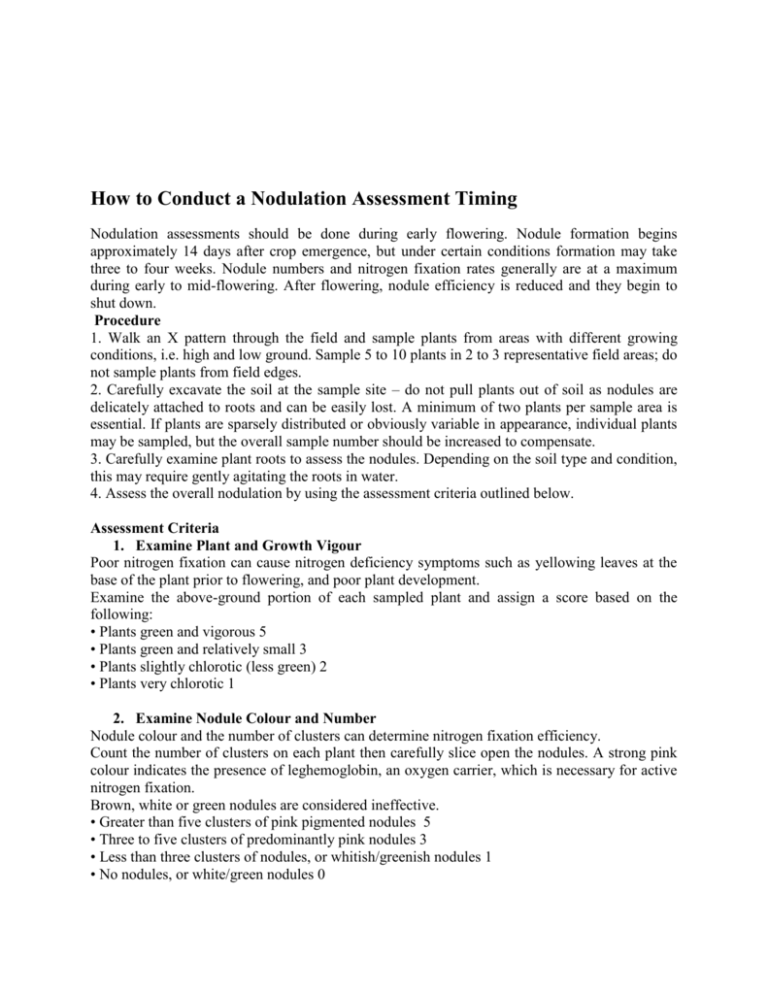
How to Conduct a Nodulation Assessment Timing Nodulation assessments should be done during early flowering. Nodule formation begins approximately 14 days after crop emergence, but under certain conditions formation may take three to four weeks. Nodule numbers and nitrogen fixation rates generally are at a maximum during early to mid-flowering. After flowering, nodule efficiency is reduced and they begin to shut down. Procedure 1. Walk an X pattern through the field and sample plants from areas with different growing conditions, i.e. high and low ground. Sample 5 to 10 plants in 2 to 3 representative field areas; do not sample plants from field edges. 2. Carefully excavate the soil at the sample site – do not pull plants out of soil as nodules are delicately attached to roots and can be easily lost. A minimum of two plants per sample area is essential. If plants are sparsely distributed or obviously variable in appearance, individual plants may be sampled, but the overall sample number should be increased to compensate. 3. Carefully examine plant roots to assess the nodules. Depending on the soil type and condition, this may require gently agitating the roots in water. 4. Assess the overall nodulation by using the assessment criteria outlined below. Assessment Criteria 1. Examine Plant and Growth Vigour Poor nitrogen fixation can cause nitrogen deficiency symptoms such as yellowing leaves at the base of the plant prior to flowering, and poor plant development. Examine the above-ground portion of each sampled plant and assign a score based on the following: • Plants green and vigorous 5 • Plants green and relatively small 3 • Plants slightly chlorotic (less green) 2 • Plants very chlorotic 1 2. Examine Nodule Colour and Number Nodule colour and the number of clusters can determine nitrogen fixation efficiency. Count the number of clusters on each plant then carefully slice open the nodules. A strong pink colour indicates the presence of leghemoglobin, an oxygen carrier, which is necessary for active nitrogen fixation. Brown, white or green nodules are considered ineffective. • Greater than five clusters of pink pigmented nodules 5 • Three to five clusters of predominantly pink nodules 3 • Less than three clusters of nodules, or whitish/greenish nodules 1 • No nodules, or white/green nodules 0 3. Examine Nodule Position Inoculated seeds tend to form nodules primarily in the crown region, while lateral nodulation is common when granular inoculants are used, or when native rhizobia species exist in the soil. The crown region is the area of soil surrounding the seed and varies according to the crop. For example, the crown region for peas can be visualized as a cylinder extending approximately 8 cm to 10 cm deep from the soil surface, with an 8 cm diameter. • Crown and lateral nodulation 3 • Generally crown nodulation 2 • Generally lateral nodulation 1 Calculate Your Total Score Add up your assessments for a total nodulation score per plant and use the following score sheet to determine your crop’s nitrogen fixing potential. Total Score = 11 to 13 • Nodulation Assessment: Effective Nodulation • Nitrogen Fixing Potential: Good. No further Steps required Total Score = 7 to 10 • Nodulation Assessment: Less effective nodulation • Nitrogen Fixing Potential: Reduced. Check inoculation method for errors; could also be a result of less than optimal growing conditions. Total Score = 1 to 6 • Nodulation Assessment: Unsatisfactory • Nitrogen Fixing Potential: Poor. Re-evaluate inoculants used, inoculation method and growing conditions.
